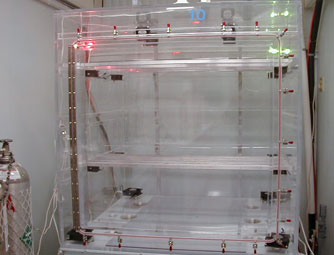MIXED FLOWING GAS
ABOUT
Take a tour of Mixed Flowing Gas: 1 | 2 | 3 | 4 | 5 | 6
PURPOSE:What is Mixed Flowing Gas? Why was it developed and what will it do for us?
Mixed Flowing Gas Testing is essentially low levels of gas exposure - in the parts per billion range - in a closely controlled temperature and humidity chamber. The gases used are chlorine, hydrogen sulfide, nitrogen dioxide and sulfur dioxide – gases that commonly exist in the atmosphere we breathe.
Mixed flowing gas tests (MFG) are environmental test procedures whose primary purpose is to evaluate product performance under simulated storage or operating (field) conditions. For parts involving plated contact surfaces, such tests are also used to measure the effect of plating degradation (due to the environment) on the electrical and durability properties of a contact or connector system. The specific test conditions are usually chosen as to simulate, in the test laboratory, the effects of certain representative field environments or environmental severity levels on standard metallic surfaces. MFG tests that are based upon such environmental classes or severity levels are particularly useful for evaluating several aspects of the connector system:
- Contact surfaces plated with gold or other precious metal coatings (edge creep or pore corrosion).
- The effectiveness of connector housings and shrouds as barriers to prevent atmospheric corrodants from attacking the contact surfaces.
- The result of metal to metal contact areas from said environment when the connectors are in the mated and/or unmated condition.
- The impact of wear particularly on palladium nickel or “soft” plating systems.
This test is performed in accordance with several industry specifications and test procedures such as:
- EIA 364, Test Procedure 65A
- IEC 60068-2-60
- IEC 512-11-7
- ASTM B827-92
For more information on this or any service we provide, please feel free to contact us at:
email:info@contechresearch.com
phone: (508) 226-4800
or fax: (508) 226-6869
